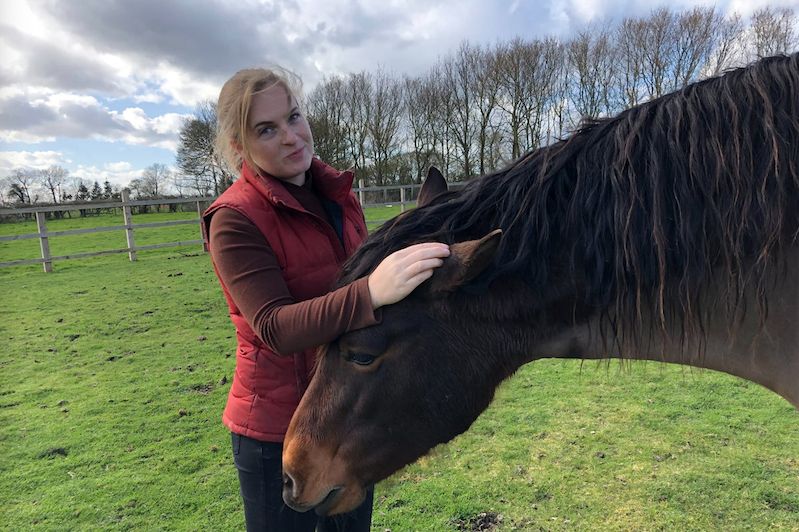Supporting Horses with PSSM

Written by Briony Witherow MSc RNutr. FHEA
Supporting Horses with PSSM
This month’s blog is all about Polysaccharide Storage Myopathy, abbreviated to PSSM, or more commonly referred to as ‘tying up’ which is a clinical issue affecting muscle function in horses.
What is it?
The condition of PSSM is thought to prevent normal breakdown, absorption, and storage of glycogen (the storage form of glucose or sugar) resulting in a build-up of glycogen within the muscles causing general fatigue, stiffness, sweating and a reluctance to move. These symptoms typically occur at the start of or immediately after exercise, particularly in the unfit or irregularly exercised horse.
Diagnosis of PSSM is based on either genetic testing and/or muscle biopsy. However, further research into PSSM has indicated significant breed predisposition, making this another key factor in diagnosis. A muscle biopsy from a horse with PSSM under a microscope would show a build-up of stored sugar in clusters (rather than evenly spread) inside muscle cells.
More recent research has meant that PSSM can be further classified into either type 1 or type 2.
- PSSM type 1 is characterised by a genetic mutation in the glycogen synthase-1 gene (GYS1). This type is more prevalent in halter bred quarter horses and related breeds (such as warmbloods and draught horses), although, it should be noted that in the latter, symptoms may be less consistent.
- PSSM type 2, lacks the mutation seen in type 1, but upon muscle biopsy has the same abnormal glycogen accumulation, indicating abnormal sugar storage. PSSM type 2 is thought to be more common in reining, racing, and cutting Quarter Horses and Warmbloods.
At this point, it should be noted that genetic testing can only be used to identify PSSM type 1. At present, there is no scientifically validated test available for PSSM type 2.
We still have much more to learn about PSSM, in particular the classification of type 1 and 2. At present, this classification appears more distinct with quarter horses as compared to other breeds; leading researchers to consider the possibility of breed dependant causes for PSSM type 2. This possibility may mean that for a subset of horses, nutritional management alone (as would be recommended for PSSM type 1) may not result in improved performance.
How can nutrition Help?
PSSM and nutrition are fundamentally linked which is why it should form a key part of management for affected horses. The following nutritional management is recommended for horses diagnosed or with suspected muscle myopathies (including PSSM).
The fundamentals upon which the diet should be based are as follows:
- The foundation of the diet should be an appropriate forage source – ideally a more mature hay or haylage (crunchy in the hand) and if turned out on pasture, the horse may benefit from some restriction during periods of high growth (spring and autumn).
- Starch and sugar levels in the diet should be kept low (<10% starch and sugar combined).
- Where more calories or energy is required, this should be sourced from fats and oils (avoiding high-starch cereal-based feeds).
- Ensure the diet is fully balanced with vitamins and minerals. In addition to this, ensure adequate salt provision (30-50g per day); this should be considered a fundamental step in ensuring a balanced ration. You can either pop basic table salt into the bucket feed or use a salt lick. If your horse regularly uses a salt lick, as a guide a 2.5kg salt lick should last 1 ½ -2 ½ months. Further to this, if workload warrants, an electrolyte supplement should also be provided. Electrolyte balance is essential to support correct muscle and nerve function and as such is a key diet checkpoint.
- Employ feed management tactics to promote movement and reduce stress. Monitor workload and performance closely. It can be useful to keep a diary of workload and management and reflect upon these regularly to ensure that any changes are mirrored in all aspects of the horse’s care (i.e., when workload is reduced, so is bucket feed).
Additional Supplementation
Research supports that horses suffering with muscle myopathies benefit from receiving twice the standard recommended amount of antioxidants per day. As such, antioxidant supplementation such as Premier E is recommended. The quantity required largely depends on the antioxidant content of the existing ration (including access to pasture) and workload. Please feel free to get in touch and we can review the current ration and make suitable recommendations @ nutritionist@equineproducts-ukltd.com
Take Home Points:
- Successful management of PSSM requires dietary adjustments alongside changes to management, in particular exercise.
- Take a holistic approach – review the whole diet and management before reaching for supplements.
- Additional antioxidants are often required but the quantity of these should be considered in light of the existing diet and workload.
- There are additional supplements which can help to support muscle health but getting the base diet right and general management is a good place to start.
If you would like a diet review to see what changes might help support your horse, please do not hesitate to get in touch.

1 comment
My horse has tested negative for PSSM 1but the test for PSSM 2 was £250 and I couldn’t afford that so decided to treat her as if she has PSSM 2 with pure vit E protein powder herbal chaff with no additives in and a low cal balancer just want to see if there is anything else I can do she does seem less tightly muscled and a lot looser